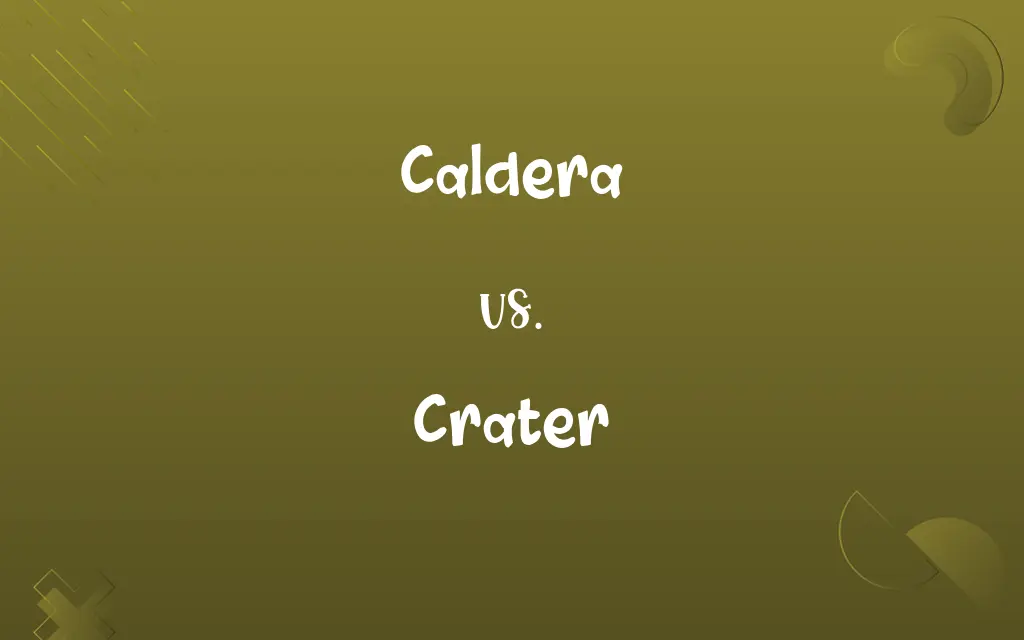Caldera vs. Crater: Know the Difference

By Shumaila Saeed || Published on December 28, 2023
A caldera is a large depression formed by the collapse of a volcano after an eruption, while a crater is a bowl-shaped indentation caused by volcanic activity or an impact event.

Key Differences
A caldera is a large, often circular depression that forms when a volcano erupts and collapses, typically leaving a sizable, sometimes lake-filled basin. In contrast, a crater is generally smaller and formed either by the outward explosion of rocks and other materials during a volcanic eruption or by the impact of a meteorite.
Shumaila Saeed
Dec 28, 2023
Calderas are known for their immense size, often spanning several kilometers in diameter; they can be a result of a single massive eruption or a series of eruptions over time. Craters, on the other hand, are usually smaller and can vary in size, but they are distinctly different in their formation, being the direct result of either an explosive volcanic event or an external impact.
Shumaila Saeed
Dec 28, 2023
The formation process of a caldera involves the emptying of a magma chamber beneath a volcano, causing the overlying land to collapse. This process is usually more complex and gradual compared to the formation of a crater, which is often a more sudden and violent event resulting from an explosion or impact.
Shumaila Saeed
Dec 28, 2023
While both calderas and craters are associated with volcanic activity, not all craters are volcanic. Some craters, known as impact craters, are formed by the collision of a meteorite, asteroid, or comet with the Earth's surface. Calderas, however, are exclusively volcanic in origin.
Shumaila Saeed
Dec 28, 2023
Calderas can have significant ecological and geological impacts, often forming unique habitats and influencing local climate patterns. Craters, especially impact craters, can also affect the environment, but they are more recognized for their role in providing insights into planetary geology and the history of celestial impacts.
Shumaila Saeed
Dec 28, 2023
ADVERTISEMENT
Comparison Chart
Origin
Formed by the collapse of a volcano post-eruption
Formed by volcanic activity or impact events
Shumaila Saeed
Dec 28, 2023
Size
Generally larger, spanning several kilometers
Varies, typically smaller than calderas
Shumaila Saeed
Dec 28, 2023
Formation Process
Collapsing of land due to emptied magma chamber
Explosion or impact causes a bowl-shaped indentation
Shumaila Saeed
Dec 28, 2023
Types
Exclusively volcanic in origin
Can be volcanic or impact (from meteorites)
Shumaila Saeed
Dec 28, 2023
Ecological Impact
Influences habitats and climate
Offers geological insights, affects environment
Shumaila Saeed
Dec 28, 2023
ADVERTISEMENT
Caldera and Crater Definitions
Caldera
A caldera is a large volcanic depression formed by the collapse of a volcano.
Yellowstone National Park is home to a famous caldera formed thousands of years ago.
Shumaila Saeed
Dec 13, 2023
Crater
A crater is a bowl-shaped indentation formed by volcanic eruptions or meteorite impacts.
The Barringer Crater in Arizona is a well-preserved impact crater.
Shumaila Saeed
Dec 13, 2023
Caldera
Many calderas become lakes if they collect water over time.
The Taupo Caldera in New Zealand is now a large, scenic lake.
Shumaila Saeed
Dec 13, 2023
Crater
Volcanic craters are typically found at the summit of volcanoes.
The summit of Mount Fuji is graced by a classic volcanic crater.
Shumaila Saeed
Dec 13, 2023
Caldera
Calderas are often characterized by their expansive size and circular shape.
The Crater Lake in Oregon is a stunning caldera that now holds a deep lake.
Shumaila Saeed
Dec 13, 2023
ADVERTISEMENT
Crater
Impact craters are formed by the collision of extraterrestrial bodies with Earth.
The Chicxulub Crater in Mexico is believed to be linked to the extinction of the dinosaurs.
Shumaila Saeed
Dec 13, 2023
Caldera
Calderas form when a magma chamber empties and the land above collapses.
The Toba Caldera in Indonesia was formed after a supereruption about 74,000 years ago.
Shumaila Saeed
Dec 13, 2023
Crater
Craters can vary in size from small pits to large basins.
Mount St. Helens has a prominent crater formed after its 1980 eruption.
Shumaila Saeed
Dec 13, 2023
Caldera
Calderas are distinct from craters due to their formation and size.
The La Garita Caldera in Colorado is one of the world's largest calderas, dwarfing typical volcanic craters.
Shumaila Saeed
Dec 13, 2023
Caldera
A large crater formed by volcanic explosion or by collapse of a volcanic cone.
Shumaila Saeed
Dec 10, 2023
Crater
A bowl-shaped depression created by the activity of a volcano or geyser.
Shumaila Saeed
Dec 10, 2023
Caldera
(vulcanology) A large crater formed by collapse of the cone or edifice of a volcano.
Shumaila Saeed
Dec 10, 2023
Crater
A bowl-shaped depression in a surface made by an explosion or the impact of a body, such as a meteoroid.
Shumaila Saeed
Dec 10, 2023
Caldera
A large crater caused by the violent explosion of a volcano that collapses into a depression
Shumaila Saeed
Dec 10, 2023
Crater
To make craters in:"The missiles did not ... crater the airfield"(Tom Clancy).
Shumaila Saeed
Dec 10, 2023
Crater
To fail utterly:"talked about how tough times were in Texas since the oil business cratered"(Stephen Coonts).
Shumaila Saeed
Dec 10, 2023
Crater
(astronomy) A hemispherical pit created by the impact of a meteorite or other object.
Shumaila Saeed
Dec 10, 2023
Crater
(geology) The basin-like opening or mouth of a volcano, through which the chief eruption comes; similarly, the mouth of a geyser, about which a cone of silica is often built up.
Shumaila Saeed
Dec 10, 2023
Crater
(figurative) To collapse catastrophically; to become devastated or completely destroyed.
Shumaila Saeed
Dec 10, 2023
Crater
(snowboarding) To crash or fall.
He cratered into that snow bank about five seconds after his first lesson.
Shumaila Saeed
Dec 10, 2023
Crater
The basinlike opening or mouth of a volcano, through which the chief eruption comes; similarly, the mouth of a geyser, about which a cone of silica is often built up.
Shumaila Saeed
Dec 10, 2023
Crater
A faint constellation in the southern hemisphere near Hydra and Corvus
Shumaila Saeed
Dec 10, 2023
Crater
A bowl-shaped depression formed by the impact of a meteorite or bomb
Shumaila Saeed
Dec 10, 2023
Crater
Craters can provide valuable information about volcanic activity and meteorite impacts.
The craters on the moon have helped scientists understand the history of celestial impacts.
Shumaila Saeed
Dec 13, 2023
Repeatedly Asked Queries
How is a crater formed?
A crater is formed by volcanic eruptions or by the impact of meteorites, asteroids, or comets.
Shumaila Saeed
Dec 28, 2023
What is a caldera?
A caldera is a large depression formed by the collapse of a volcano after an eruption.
Shumaila Saeed
Dec 28, 2023
What is the difference between a caldera and a crater?
A caldera is a large volcanic depression caused by the collapse of a volcano, while a crater is a smaller, bowl-shaped indentation caused by an eruption or impact event.
Shumaila Saeed
Dec 28, 2023
How large can a caldera get?
Calderas can span several kilometers in diameter.
Shumaila Saeed
Dec 28, 2023
Can craters be found on other planets?
Yes, craters are common on many celestial bodies, including moons and planets.
Shumaila Saeed
Dec 28, 2023
Are all craters caused by volcanoes?
No, some craters, known as impact craters, are formed by the collision of extraterrestrial bodies with Earth.
Shumaila Saeed
Dec 28, 2023
Can calderas be dangerous?
Calderas can be potentially dangerous due to volcanic activity, though many are dormant.
Shumaila Saeed
Dec 28, 2023
Can a caldera have water?
Yes, many calderas collect water over time and become lakes.
Shumaila Saeed
Dec 28, 2023
Do calderas affect the environment?
Yes, calderas can influence local habitats and climate patterns.
Shumaila Saeed
Dec 28, 2023
What are some famous calderas?
Yellowstone Caldera and Crater Lake are among the most famous calderas.
Shumaila Saeed
Dec 28, 2023
Are impact craters always round?
Most impact craters are round due to the explosive force distributing equally from the point of impact.
Shumaila Saeed
Dec 28, 2023
What insights do craters provide?
Craters can offer valuable information about geological history, including volcanic activity and meteorite impacts.
Shumaila Saeed
Dec 28, 2023
Do calderas exist under the sea?
Yes, submarine calderas exist and are formed by volcanic activity under the ocean.
Shumaila Saeed
Dec 28, 2023
What is the significance of studying craters?
Studying craters helps in understanding planetary geology and the history of celestial impacts.
Shumaila Saeed
Dec 28, 2023
Can calderas be tourist attractions?
Many calderas are popular tourist destinations due to their unique landscapes and ecological significance.
Shumaila Saeed
Dec 28, 2023
Do calderas evolve over time?
Yes, calderas can evolve over time due to ongoing geological processes.
Shumaila Saeed
Dec 28, 2023
How do scientists study calderas?
Scientists use various methods like satellite imagery, geological surveys, and studying rock formations to understand calderas.
Shumaila Saeed
Dec 28, 2023
How long does it take for a crater to form?
The formation of a crater can be instantaneous in the case of impacts, while volcanic craters may form over a longer period due to eruptive activity.
Shumaila Saeed
Dec 28, 2023
How are impact craters different from volcanic craters?
Impact craters are formed by the collision of a meteorite, asteroid, or comet, while volcanic craters are formed by volcanic activity.
Shumaila Saeed
Dec 28, 2023
What is the largest known crater on Earth?
The Vredefort Crater in South Africa is one of the largest known impact craters on Earth.
Shumaila Saeed
Dec 28, 2023
Share this page
Link for your blog / website
HTML
Link to share via messenger
About Author
Written by
Shumaila SaeedShumaila Saeed, an expert content creator with 6 years of experience, specializes in distilling complex topics into easily digestible comparisons, shining a light on the nuances that both inform and educate readers with clarity and accuracy.









































































